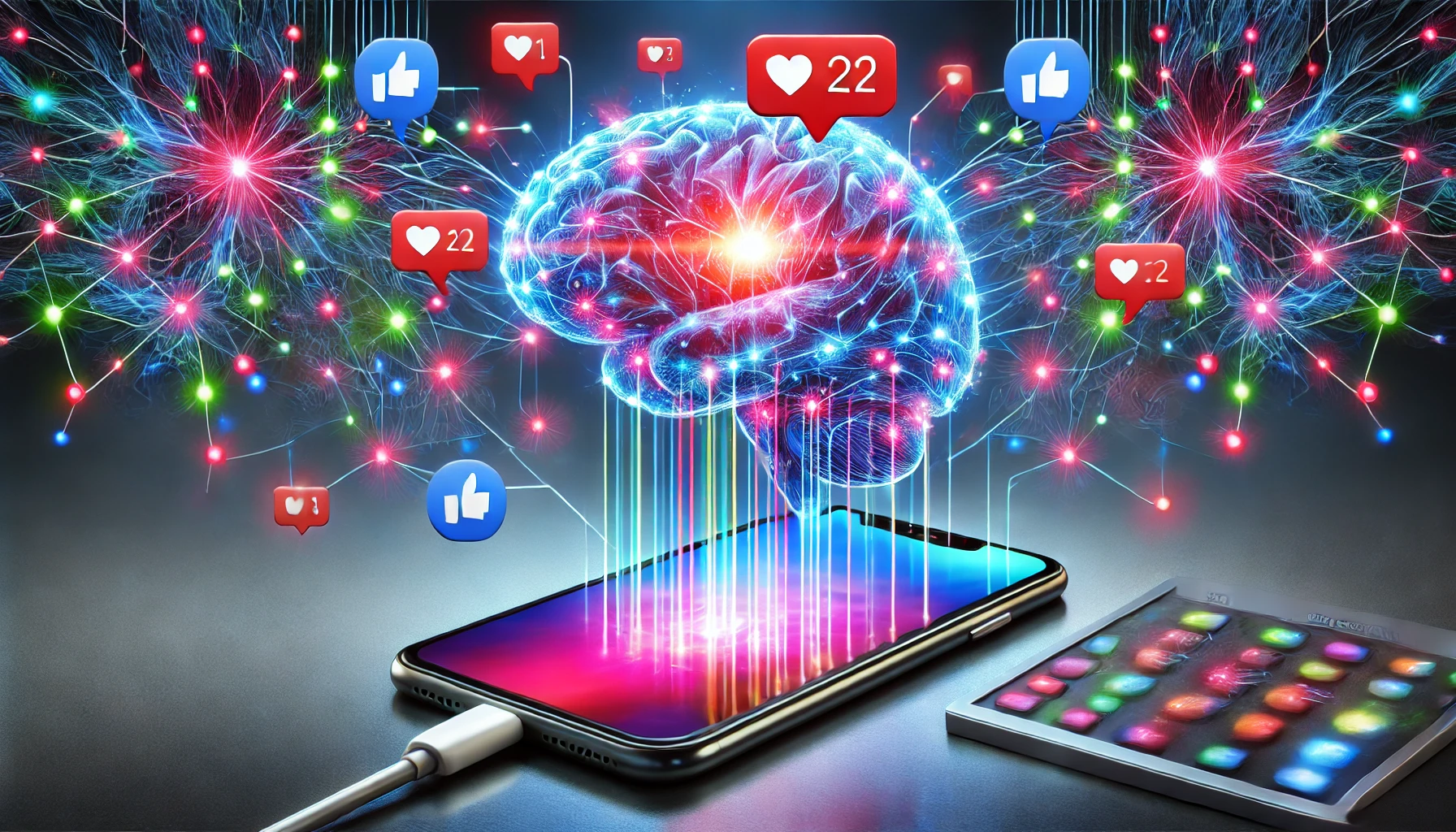The Neuroscience of Smartphone Addiction: Why We Can’t Put Our Phones Down. In the modern era, smartphones have become indispensable tools for communication, work, and entertainment. While they enhance our productivity and connectivity, they also have a darker side: the potential for addiction. Ever wonder why it’s so hard to resist picking up your phone or why notifications feel impossible to ignore? The answer lies in the intricate workings of our brain and the intentional design strategies employed by tech companies. This article delves deeply into the neuroscience behind smartphone addiction, its consequences, and strategies to reclaim balance in a hyperconnected world.
What Is Smartphone Addiction?
Smartphone addiction, often categorized as a form of behavioral addiction, refers to excessive and compulsive phone use that interferes with daily life. Unlike substance addiction, which relies on chemical dependency, smartphone addiction exploits psychological mechanisms to create dependency. Common signs include:
- Frequent checking of the phone: Even without receiving notifications.
- Difficulty focusing on tasks: Feeling the urge to check updates during work or study.
- Anxiety when separated from the phone: Experiencing discomfort or unease without it.
The global prevalence of smartphone addiction is increasing, with studies estimating that over 40% of the population exhibits signs of problematic use. Its rise is not limited to any specific demographic, affecting teenagers, working professionals, and even the elderly.
The Neuroscience Behind Smartphone Addiction
Smartphone addiction leverages natural brain processes to create a feedback loop that keeps users engaged. Here’s how it works:
1. Dopamine: The Brain’s Reward System
When you receive a notification or see a “like” on social media, your brain releases dopamine, a neurotransmitter that signals pleasure and reward. This creates a feeling of satisfaction that reinforces the behavior. Over time, the anticipation of notifications becomes just as rewarding as the notifications themselves. This phenomenon is similar to what occurs in gambling addiction.
Key Insight: Apps are designed to capitalize on this reward mechanism. Social media platforms like Instagram or Facebook strategically delay likes or comments to maximize dopamine spikes.
2. Variable Rewards and Habit Loops
Smartphones mimic the reward mechanisms of slot machines. The content you encounter – whether it’s an exciting update or a mundane notification – varies unpredictably. This variability triggers the brain’s reward system, keeping you hooked and coming back for more. As discussed in Aeon’s essay, this design raises important questions about the ethical and regulatory oversight of technology’s addictive features.
3. Neuroplasticity and Habit Formation
Repeated behaviors, such as compulsively checking your phone, create neural pathways in the brain through a process called neuroplasticity. Over time, these pathways become stronger, making the behavior automatic. This rewiring prioritizes short-term gratification over long-term focus and self-control.
Psychological Effects of Smartphone Addiction
Smartphone addiction doesn’t just affect the brain – it impacts emotional and psychological well-being:
1. Anxiety and Stress
Constant notifications and the fear of missing out (FOMO) create a perpetual state of alertness, leading to heightened anxiety levels. Studies show that smartphone users report increased stress and difficulty relaxing.
2. Attention Fragmentation
Smartphones disrupt deep work by fragmenting attention. Frequent notifications reduce productivity and impair the brain’s ability to concentrate on complex tasks for extended periods. A 2022 study found that even the mere presence of a smartphone can reduce cognitive performance.
3. Sleep Disruption
The blue light emitted by screens interferes with melatonin production, disrupting circadian rhythms. Late-night scrolling overstimulates the brain, leading to poor sleep quality and daytime fatigue.
4. Social Isolation
While smartphones are designed to connect people, overuse often has the opposite effect. Face-to-face interactions are replaced by digital communication, reducing the quality of social connections and increasing feelings of loneliness.
Societal Consequences of Smartphone Addiction
Beyond individual impacts, smartphone addiction has broader implications for society:
1. Workplace Productivity
Constant distractions from smartphones reduce efficiency, costing businesses billions annually in lost productivity. Workers who frequently check their phones are more likely to miss deadlines and make errors.
2. Educational Challenges
Students struggle to focus on learning due to frequent phone use. The habit of multitasking with devices impacts academic performance and retention of information.
3. Health Risks
Physical issues like “tech neck” and digital eye strain are becoming more common. Overuse can also lead to sedentary lifestyles, increasing the risk of obesity and related health conditions.
Breaking the Cycle: How to Overcome Smartphone Addiction
While smartphones are designed to capture your attention, there are effective ways to regain control over your habits:
1. Recognize the Problem
Self-awareness is the first step. Use tools like screen time trackers to monitor your phone usage and identify patterns of overuse. Many smartphones now come with built-in digital well-being dashboards.
2. Set Boundaries
Establish rules for when and where you use your phone. For example, designate phone-free zones such as the dining table or bedroom. This encourages meaningful interactions and better sleep hygiene.
3. Limit Notifications
Reduce the number of interruptions by turning off non-essential notifications. Prioritize alerts from apps that are critical for your work or well-being.
Explore More: For a deeper dive into how notifications impact behavior, check out The Psychology of Push Notifications.
4. Use Digital Well-Being Tools
Apps like “Focus Mode” or third-party solutions like Forest and Freedom help users stay off their phones and engage in more productive activities.
5. Replace Screen Time with Real-World Activities
Engage in hobbies or activities that don’t involve screens, such as reading, exercising, or spending time outdoors. These alternatives provide mental stimulation and relaxation without the addictive pull of a smartphone.
6. Practice Mindfulness
Mindfulness techniques, such as meditation and journaling, can help reduce anxiety and build awareness of phone usage habits.
The Role of Technology in Managing Smartphone Addiction
Paradoxically, technology itself offers solutions to the problem of smartphone addiction. Developers are increasingly incorporating features to promote healthy usage habits:
- Screen Time Management: Tools that track usage and allow users to set daily limits.
- Focus Modes: Features that block distractions during work or study sessions.
- AI-Powered Notifications: Systems that prioritize important alerts while minimizing unnecessary interruptions.
The Future of Digital Well-Being
As awareness of smartphone addiction grows, the future of digital well-being looks promising:
1. Ethical App Design
Developers are adopting user-first principles that emphasize utility over engagement. Apps are beginning to prioritize mental health and well-being over profit-driven metrics.
2. Personalized Digital Well-Being Tools
AI-driven insights will help users develop healthier tech habits tailored to their needs. These tools will provide real-time feedback and actionable recommendations.
3. Regulation and Advocacy
Governments and organizations are pushing for greater transparency and accountability in app design. Policies aimed at reducing addictive practices in tech are gaining traction worldwide.
Conclusion
Smartphone addiction is a complex issue rooted in neuroscience and psychological principles. While smartphones offer unparalleled convenience and connectivity, their design exploits natural brain processes, making them hard to resist. By understanding the science behind this behavior and implementing mindful practices, we can regain control over our technology use and foster a healthier relationship with our devices.
For a deeper dive into how notifications influence attention and behavior, check out The Psychology of Push Notifications. Additionally, explore How Social Media Is Rewiring Your Attention Span to learn more about technology’s impact on focus.





Leave a Reply